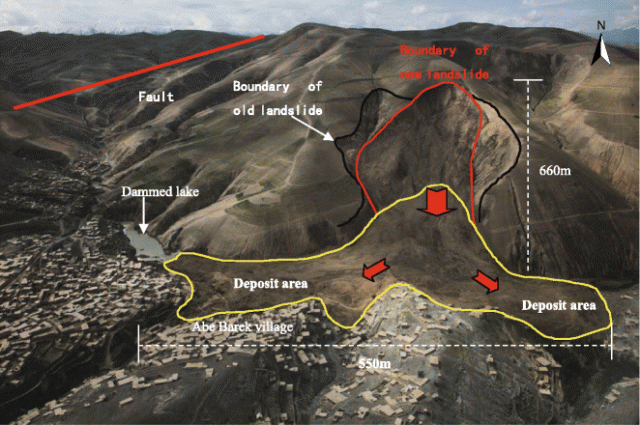25 March 2015
The Abe Barek Landslide in Badakhshan, Afghanistan
Posted by Dave Petley
The Abe Barek Landslide in Badakhshan, Afghanistan
ON 2nd May 2014 a very large landslide occurred at Abe Barek (note there are multiple spellings of this name) in Ago District, Badakhshan Province in Afghanistan. This was the worst landslide of 2014, taking the lives of up to 2700 people (although estimates vary wildly). I posted extensively about it at the time (e.g. here and here), but clearly interpretations at that point were greatly limited by the lack of information from this remote and inaccessible location. In a recent paper, Zhang et al. (2015) have undertaken what I think is the first published analysis of the landslide. They have found that, as expected, the landslide occurred in a thick deposit of loess (wind-blown silt) on a site that had previously been active. The landslide occurred in two phases about two hours apart, starting at 11 am.
Zhang et al. (2015) suggest that the key factors in the landslide were:
- A complex bedrock structure overlain by silt that had been weakened by repeated seismic events;
- A slope that had been left in an over-steepened state by previous landslides;
- A wet late winter and spring period (including a rainfall event of over 200 mm in January, with smaller rainfall episodes in the days leading up to the landslide;
- Previous landslide events that had subsequently been subject to gully erosion.
The paper says that the landslide has a vertical extent of 2400 m (top of the slope at 2700 m, foot at 300 m elevation), although this feels surprisingly high to me, and appears to be contradicted by this image from the paper:
Unfortunately the analysis does not go much further than this for understandable reasons. The remainder of the paper examines and maps the susceptibility of landslides across Badakhshan, finding that in particular on the west side of the province landslide susceptibility is quite high. Sadly this means that a repeat of this landslide is far from unlikely.
Reference
Zhang, Jianqiang; Gurung, Deo Raj; Liu, Rongkun, Murthy; Manchiraju Sri Ramachandra; Su, Fenghuan, 2015. Abe Barek landslide and landslide susceptibility assessment in Badakhshan Province, Afghanistan. Landslides. doi: http://dx.doi.org/10.1007/s10346-015-0558-5



 Dave Petley is the Vice-Chancellor of the University of Hull in the United Kingdom. His blog provides commentary and analysis of landslide events occurring worldwide, including the landslides themselves, latest research, and conferences and meetings.
Dave Petley is the Vice-Chancellor of the University of Hull in the United Kingdom. His blog provides commentary and analysis of landslide events occurring worldwide, including the landslides themselves, latest research, and conferences and meetings.
How can I post one picture of an same landslides ?